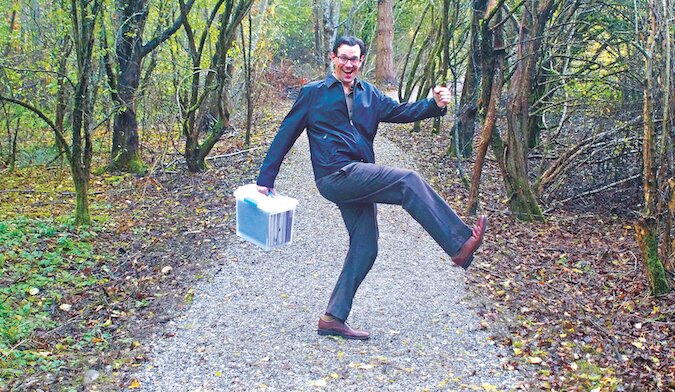 Shredder of red tape. When it comes to building trails, the box of paperwork that precedes any digging is just as important as shovels and excavators. Todd Elsworth shows what it took to build the 18th Street Connector Trail at Fairhaven Park.
Shredder of red tape. When it comes to building trails, the box of paperwork that precedes any digging is just as important as shovels and excavators. Todd Elsworth shows what it took to build the 18th Street Connector Trail at Fairhaven Park.The Bellingham-based non-profit Recreation Northwest expanded its role from race organizer to environmental steward in 2014, and less than a year later, their first trail build looks like it has always been there. The 18th Street Connector Trail in Fairhaven Park is the first step in making Fairhaven Park a better place to play. The hope is to find a balance between recreation, stewardship and even education.
MBE: How did Recreation Northwest become stewards of Fairhaven Park?
Todd Elsworth: Two years ago, we knew stewardship was going to be an important part of the work we were doing, we just didn’t know what that meant. I sat down and had a conversation with Saul Weisberg, the founder of North Cascades Institute, who I idolize because of his amazing work around conservation and stewardship. He said to just pick a place and start taking care of it, and I thought, wow, that’s a great idea. The most logical place for us to choose was Fairhaven Park, because we’ve been running the Bellingham Traverse through there for the last 10 years and our mission is to take care of the places where we play.
MBE: Tell me about the trail.
TE: It’s 750 feet. It’s not a long trail but it’s significant because of the connectivity it provides between 18th Street and Fairhaven Park. Before, it was a muddy mess. No one was going in there, and now it’s a 6-foot wide gravel path that’s wheelchair accessible. We moved the trail up out of the wetlands and found the best path to make the connection between 18th street and Fairhaven Park.
MBE: What kind of permitting had to be done before construction?
TE: Perry Welch of Welch Environmental did our wetland delineation, and Andy Law at Wilson Engineering as our surveyor. With Perry’s report and Law’s report, I filled out two city permits: a critical areas permit and a stormwater permit. That whole process was educational, and I thank Kim Weil and Jason Porter at the city of Bellingham for their help.
MBE: How did you raise money for the project?
TE: Recreation Northwest’s staff and board reached out to friends and family, past participants of our events and people around town. We had over 90 donors, and we raised more than $30,000 of cash and in-kind services by the end of the year. Hats off to each of our contractors, because they each donated a portion of their time and expertise.
I owe a big “Thank You” to the Fairhaven Lions. They came in with an $8,300 donation at the end to help us meet our goal. And I am also now a proud Fairhaven Lion!
MBE: What was the construction process like?
TE: The leading role in all this is Gerry Wilbour. He owns Northwest Trails, and he’s been building trails for decades all over the country and the world. The great thing about working with Gerry is, because of his experience, we’re able to build the most rewarding experience for people visually and movement wise.
After we figured out the best path, I came through and cleared a bunch of stuff out of the way so Gerry could get in there with his equipment, and then he basically went in there and plowed a line through. He did all his work on the weekends, pulling his crew and guys from around the state to come back and do this stuff. We had over 100 volunteers come in over the course of five weeks. Q Laundry and the Alcoa Foundation, with the Intalco plant in Ferndale, brought their crews in for works days which were really fun. Then we had Boy Scouts putting moss on the side of the trail, and now if you go there it looks like it’s been there for years.
MBE: What’s next?
TE: Phase Two, as we’re calling it, is to cross the wetland. There’s an old trail that over the years has gotten wider and wider because people keep going around the mud. We’re going to move the trail to the east so it comes up into a whole other wetland forest with huge trees but a beautiful open canopy. After that, we’ll continue to work with the forest district, the parks department and the community to develop a master plan for the whole park.
MBE: Will there be mountain biking trails?
TE: Our plan is to get a group of middle schoolers together to work with Eric Brown at Whatcom Mountain Bike Coalition (WMBC) and the forest district, and they’re going to help design and build mountain bike trails in an area that was once a gravel pit. EB and I are going to get together and start formulating how we’re going to do this, but we’re thinking the middle schoolers will be able to design the trails with guidance from EB and Bill Hasenjaeger, who is the BPRD liaison to the forest district. The kids will also do most of the actual building.
MBE: Why are trails important?
TE: The biggest thing is access: to provide access for people to get out and get a little touch of nature in an urban forest. This is an urban forest that we’re lucky to have. You can get out there and it’s immediately peaceful. x